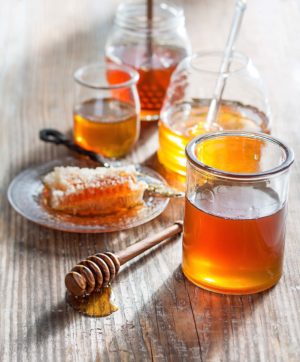
Spring is in the air and, while it may not be here quite yet, we know that very soon the flowers will bloom and the bees will be buzzing. It's always around this time of year that we really get a chance to think about all the great things that the honey bee does and represents.
Are you aware of the vital second shift of the honey bee's pollination work? Fun fact: one in every three bites of food we eat is derived from insect pollination and honey bees are responsible for about 80% of this process. Thanks to the honey bee, we get to enjoy some of our favorite fruits, veggies and nuts, like cherries, cucumbers and almonds, and because they assist in the pollination of alfalfa, which is often fed to cattle, we can also thank them for our beef too. This pollination work does more than just provide us with the tasty items on our plates, it also gives us many flavorful varieties of honey to enjoy.
Did you know that there are more than 300 varietals of honey found in the United States alone? Because honey bees create honey from the nectar of nearby flowers in which they are foraging, the look and taste of each honey is unique and distinctive. You may find that some honeys are very dark in color and bold in flavor, like Buckwheat honey, while others are very light to nearly colorless and mild in flavor, such as Acacia honey. What makes honey even more unique is that, although honey bees may forage in the same area of flowers every year, the honey they create may still differ from year to year due to changes in nectar produced, depending upon temperature and rainfall in the area.
Here at the National Honey Board (NHB), we feel that it is the pure simplicity of honey that makes it so inspirational. With nothing added along the way from flower to your table, honey truly is as close to nature as an ingredient can get. And, while honey is great in tea and drizzled on biscuits, there is still so much more that this simple ingredient can do to enhance your favorite dishes.
While honey is a wonderful sweetener, being slightly sweeter than sugar allows you to use less to achieve the same amount of sweetness in a dish, honey's versatility also benefits your savory recipes. As an emulsifier, honey is a great binder in sauces, dips, marinades and even your favorite homemade granola bar. Honey's humectant properties also make it the perfect ingredient to add to cooked meats and baked goods, retaining moisture to ensure tender meats and even extending the shelf life of breads, muffins and cookies. And one of honey's most unique features is its ability to play well with other ingredients, enhancing flavors and bringing balance to sweet and spicy or sweet and sour recipes. All of these characteristics just go to show that honey really is your sweetest kitchen sidekick.
From beautiful flowers to delicious eats, there is so much to thank the honey bee for. To learn more about the pure inspiration that is honey, feel free to explore the new www.honey.com where you will find information on bees and honey's journey, where to buy various types of honey, and delicious recipes with honey. We hope you feel as inspired by nature's sweet gift as we do.
